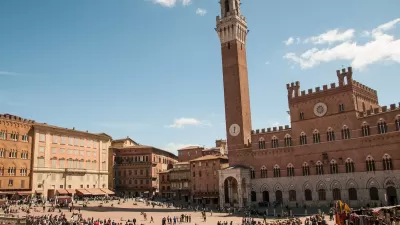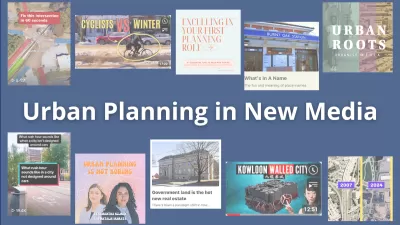Urban planning can be an exciting and rewarding profession. It can also be extremely political and sometimes downright boring.

Urban planning can be an exciting and rewarding profession. It can also be extremely political and sometimes downright boring. You sit there, review requests for development applications, subdivision requests, zoning amendments, variances, and general plan amendments. You look at the intent and you look for compliance and consistency. Compliance and consistency. Order and geometry. Physical, social, economic and cultural impacts, which no one can ever predict.
Instead of coming up with fresh creative ideas, dig deep and look for ways to adapt to changing environmental, social and economic conditions, planners continue to create cities with pedestrians segregated from cars, low density neighbourhoods with large footprint totally dependant on the automobile. Why? Because that is what people want and that is what council wants: safe and orderly cities. We want things to remain the same.
Nevertheless, there are ways to keep your job as an urban planner interesting. When executed well, urban planning takes care of the people living in the urban communities being planned. Good planning is a dynamic process that involves planners, citizens, businesses, and community leaders, with the aim of creating cities that is vibrant. An orderly city and a consistent city is not a vibrant city.
Traditionally, planners have relied on basic geometry when determining how to lay out neighbourhoods and districts. While this can make it easy to pinpoint a particular place on the map, orderly, linear cities lack creativity. Naturally, building a city is going to require some degree of geometric prowess when it comes to urban planning techniques, but it’s okay for planners to get creative and disorderly. In fact, you should. For example, fold business districts into the hubs of neighbourhoods, giving residents places close by to work and narrowing the commute window.
Focus on Needs
When you focus on communities’ needs, particularly with regards to transportation and affordable housing, you can create a more sustainable city. It becomes easier to encourage a collaborative and sharing economy within the city, and it certainly makes it easier for the residents in the city to build a sense of community.
Moreover, when focusing on needs, you create a more dynamic position for yourself. No longer does urban planning entail following what has worked and what has always been done. Instead, it involves getting out there, connecting with homeowners and renters, business owners, and politicians to discuss how to meet the needs of an ever-changing urban area.
Tech Tools Help
Rather than sitting in your chair and pushing buttons to design a city that has been created many times, use planning technology and apps to help put together the city of everyone’s dreams. Not only can you create surveys that will elicit results telling you what sorts of features your community wants and needs, but you can also simplify the design process, leaving more time to discuss how things will change with leaders.
Harness the Power of the Crowd
Turning to a large group of people to help solve difficult problems is not a new thing. Take NASA for example. NASA is founded on solving incredibly tough problems but NASA believe in the power of open innovation to help address incredibly complex problems in collaboration with the crowd. So take a note from NASA’s books and look for wisdom in the crowd. Welcome and embrace the crowd and find creative solutions to complex problems. Turn to one of the many crowdsourcing sites and start harnessing ideas without leaving the office.
Get out There
If the internet and the tech world is not your thing, then get out there and talk to people. When you’re working on a particular neighbourhood or business or industrial district, go there. Walk around. Talk to people. See it through the eyes of the people living or working there. What’s working? What’s not working? Talk to the individuals there and ask to give you feedback: the good and the bad. Urban planners should want it all. We shouldn’t be afraid of the “bad”. People tend to judge feedback way too quickly, without really understanding what the person means.
By getting out there and talking to people, you can be on the cutting edge of urban development practices.
Affect Community Change
In one South American city, Medellin, urban change and planning actually helped to lower the murder and crime rate. While architecture was not the only reason for this drop, it is cited as being one of the key components behind the reduction. When you’re an urban planner, you have the opportunity to change your community for the better.
By seeing city design as being intertwined with social activism and safety, planning officials can work together to create urban centers that work better. Things like reliable public transportation routes that exist for all parts of the city, affordable housing option availability, and employment and education opportunities are close at hand.
Planning is Awesome
A career in urban planning doesn’t have to be boring. It’s a dynamic field, and when the job is done well, planners can have a positive, long-lasting effect on the community around them. The field of planning can, in fact, be exciting. When the right combination of creativity, technology and innovation are applied, it can be rewarding, too.
Has urban planning technology made your design projects easier and more exciting? How did you restore your oomph as an urban planner? Tell me in the comments, or Tweet to @simolapointe.
If you liked this post, you might enjoy our 3Pikas/Civicly newsletter. Receive each new post delivered right to your inbox! Sign up here.
FULL STORY: Has your urban planning profession made you boring?

Planetizen Federal Action Tracker
A weekly monitor of how Trump’s orders and actions are impacting planners and planning in America.

Chicago’s Ghost Rails
Just beneath the surface of the modern city lie the remnants of its expansive early 20th-century streetcar system.

San Antonio and Austin are Fusing Into one Massive Megaregion
The region spanning the two central Texas cities is growing fast, posing challenges for local infrastructure and water supplies.

Since Zion's Shuttles Went Electric “The Smog is Gone”
Visitors to Zion National Park can enjoy the canyon via the nation’s first fully electric park shuttle system.

Trump Distributing DOT Safety Funds at 1/10 Rate of Biden
Funds for Safe Streets and other transportation safety and equity programs are being held up by administrative reviews and conflicts with the Trump administration’s priorities.

German Cities Subsidize Taxis for Women Amid Wave of Violence
Free or low-cost taxi rides can help women navigate cities more safely, but critics say the programs don't address the root causes of violence against women.
Urban Design for Planners 1: Software Tools
This six-course series explores essential urban design concepts using open source software and equips planners with the tools they need to participate fully in the urban design process.
Planning for Universal Design
Learn the tools for implementing Universal Design in planning regulations.
planning NEXT
Appalachian Highlands Housing Partners
Mpact (founded as Rail~Volution)
City of Camden Redevelopment Agency
City of Astoria
City of Portland
City of Laramie





























